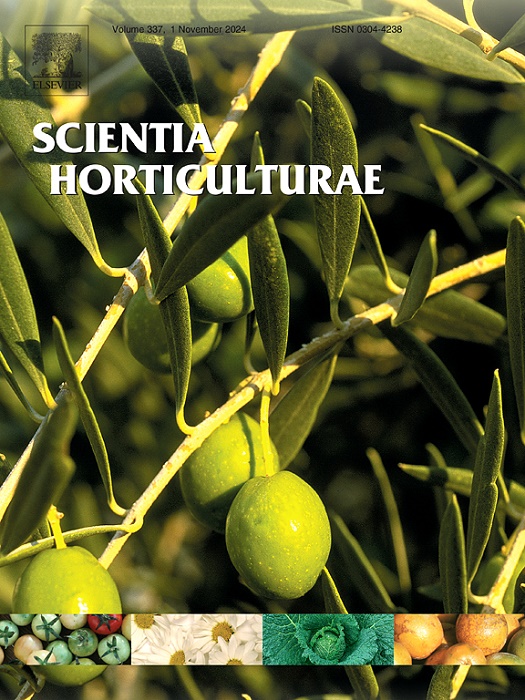Nanoformulations containing rosemary oil for gray mold control in strawberries
IF 4.2
2区 农林科学
Q1 HORTICULTURE
引用次数: 0
Abstract
Gray mold, caused by Botrytis cinerea, affects strawberry crops (Fragaria x ananassa) and can cause major losses. Managing the disease with fungicides can harm health and the environment and can lead to the selection of pathogens resistant to their active ingredients. The use of essential oils (EOs) represents an alternative control method due to their richness in antimicrobial compounds, such as rosemary EO (Rosmarinus officinalis). However, the high volatility of several components of these oils makes commercial use difficult, and nanoencapsulation presents a technology to increase stability. In the present study, three formulations containing rosemary EO—nanoemulsion (NE), nanostructured lipid carrier (NLC), and nanocapsules with chitosan (NC)—were evaluated on strawberry fruits and against the fungus. The nanoformulations retained their characteristics (mean values: size 142 nm; polydispersity index 0.131; pH 4.99; zeta potential -20.2 mV for NE and NLC, and 19.1 mV for NC) when stored at 40 °C for 60 days. All nanoformulations had a direct effect on spore germination and mycelial growth of B. cinerea, possibly due to damage caused to the cell wall and plasma membrane, and changes in the pathogen's oxidative balance. NE containing 2 % EO, when applied by immersion, reduced the incidence and severity of the disease by around 40 % and 70 %, respectively, 6 days after treatment. The fruits treated with this formulation maintained their physicochemical characteristics for longer. Thus, the use of rosemary oil from NE can be an option for managing gray mold and increasing the shelf life of the fruits.
用于控制草莓灰霉病的含迷迭香油的纳米制剂
由灰霉病菌(Botrytis cinerea)引起的灰霉病会影响草莓作物(Fragaria x ananassa),并可能造成重大损失。使用杀真菌剂防治这种疾病会损害健康和环境,并可能导致病原体对杀真菌剂的活性成分产生抗药性。精油(EOs)富含抗菌化合物,是一种替代的防治方法,如迷迭香精油(Rosmarinus officinalis)。然而,这些精油中的一些成分挥发性很强,因此很难用于商业用途,而纳米封装技术则是提高稳定性的一种技术。在本研究中,对三种含有迷迭香环氧乙烷的制剂--纳米乳液(NE)、纳米结构脂质载体(NLC)和壳聚糖纳米胶囊(NC)--在草莓果实上的使用情况和对真菌的抗性进行了评估。这些纳米制剂在 40 °C 下储存 60 天后仍能保持其特性(平均值:尺寸 142 nm;多分散指数 0.131;pH 值 4.99;NE 和 NLC 的 zeta 电位为 -20.2 mV,NC 为 19.1 mV)。所有纳米制剂都会直接影响 B. cinerea 的孢子萌发和菌丝生长,这可能是由于细胞壁和质膜受到破坏,病原体的氧化平衡发生了变化。含有 2% 环氧乙烷的 NE 采用浸泡法施用,在处理 6 天后,病害的发生率和严重程度分别降低了约 40% 和 70%。用这种制剂处理过的果实能更长时间地保持其理化特性。因此,使用东北地区的迷迭香油可以有效控制灰霉病,延长水果的货架期。
本文章由计算机程序翻译,如有差异,请以英文原文为准。
求助全文
约1分钟内获得全文
求助全文
来源期刊

Scientia Horticulturae
农林科学-园艺
CiteScore
8.60
自引率
4.70%
发文量
796
审稿时长
47 days
期刊介绍:
Scientia Horticulturae is an international journal publishing research related to horticultural crops. Articles in the journal deal with open or protected production of vegetables, fruits, edible fungi and ornamentals under temperate, subtropical and tropical conditions. Papers in related areas (biochemistry, micropropagation, soil science, plant breeding, plant physiology, phytopathology, etc.) are considered, if they contain information of direct significance to horticulture. Papers on the technical aspects of horticulture (engineering, crop processing, storage, transport etc.) are accepted for publication only if they relate directly to the living product. In the case of plantation crops, those yielding a product that may be used fresh (e.g. tropical vegetables, citrus, bananas, and other fruits) will be considered, while those papers describing the processing of the product (e.g. rubber, tobacco, and quinine) will not. The scope of the journal includes all horticultural crops but does not include speciality crops such as, medicinal crops or forestry crops, such as bamboo. Basic molecular studies without any direct application in horticulture will not be considered for this journal.
 求助内容:
求助内容: 应助结果提醒方式:
应助结果提醒方式:


